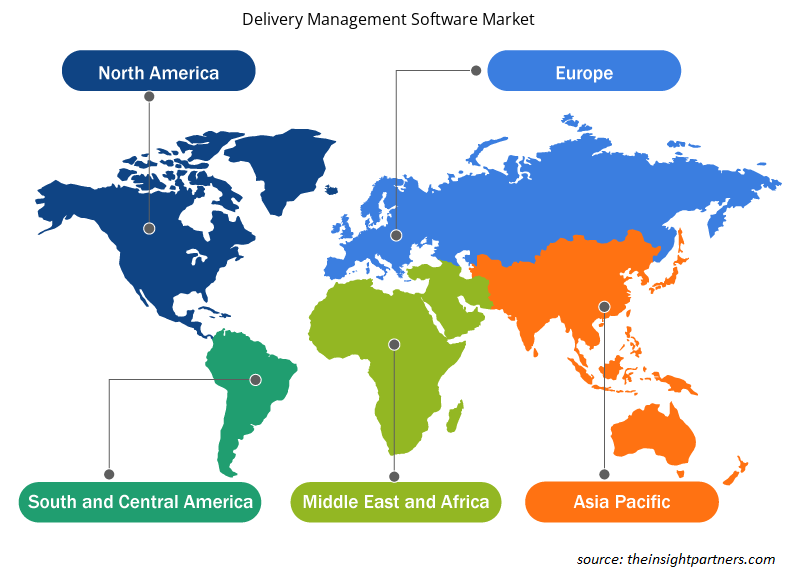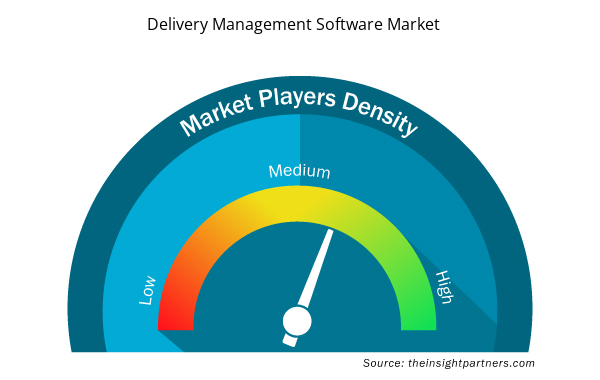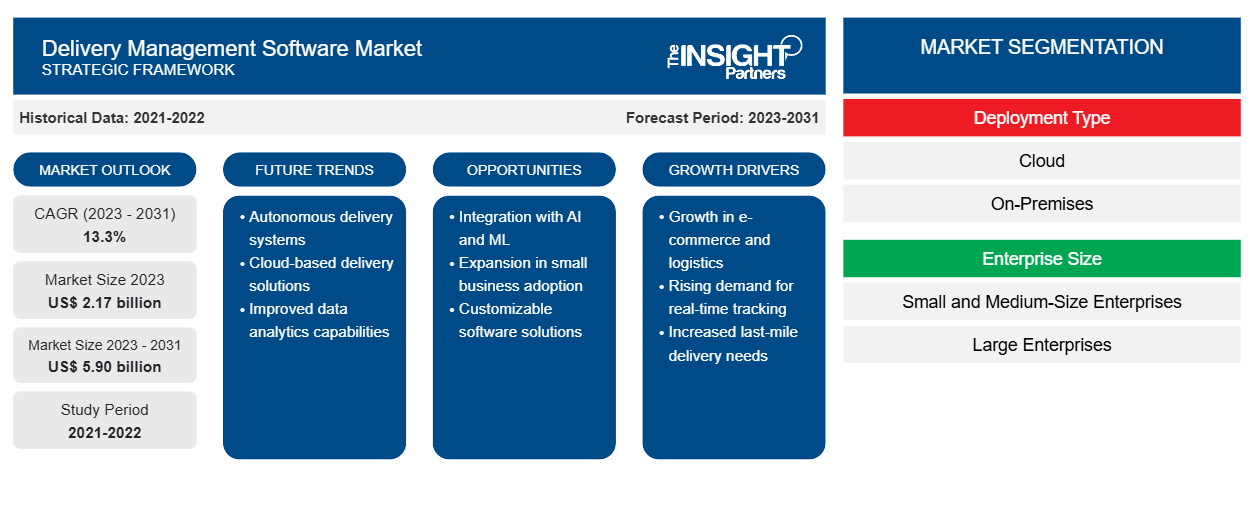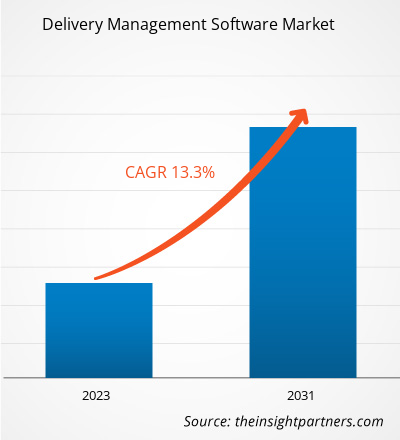Das Marktvolumen für Liefermanagement-Software soll von 2,17 Milliarden US-Dollar im Jahr 2023 auf 5,90 Milliarden US-Dollar im Jahr 2031 anwachsen. Von 2023 bis 2031 wird für den Markt eine durchschnittliche jährliche Wachstumsrate (CAGR) von 13,3 % erwartet.
Die Integration von KI- und ML-Technologien in die Liefermanagement-Software zur Verbesserung des Kundenerlebnisses wird wahrscheinlich ein wichtiger Markttrend für Liefermanagement-Software bleiben.
Marktanalyse für Liefermanagementsoftware
Der Markt für Liefermanagementsoftware wächst aufgrund der wachsenden E-Commerce-Branche und der steigenden Nachfrage nach Echtzeitinformationen zur Verwaltung von Logistik und Lieferketten rasant. Der Markt wächst stetig, angetrieben von der wachsenden Bevölkerung, der zunehmenden Digitalisierung und der Vorliebe der Verbraucher für Online-Shopping. Darüber hinaus bietet die wachsende Nachfrage der Endbenutzer nach Automatisierung lukrative Möglichkeiten für Marktwachstum.
Marktübersicht für Liefermanagementsoftware
Mithilfe von Liefermanagementsoftware können Sendungen verfolgt und eine pünktliche Zustellung von Artikeln an Kunden sichergestellt werden. Der Einsatz innovativer Liefermanagementsoftware bietet Unternehmen erhebliche Vorteile, darunter eine höhere Anlagenauslastung, eine höhere Kundenzufriedenheit und einen geringeren Kraftstoffverbrauch. Die Software verbindet den Zusteller und die Back-End-Büros auf einer einzigen Plattform und stellt die Informationen bereit, die ein Zusteller zur Zustellung eines Artikels benötigt. Die wachsende Nachfrage nach Echtzeitinformationen und verbesserter Lieferverfolgung beflügelt den Markt.
Passen Sie diesen Bericht Ihren Anforderungen an
Sie erhalten kostenlose Anpassungen an jedem Bericht, einschließlich Teilen dieses Berichts oder einer Analyse auf Länderebene, eines Excel-Datenpakets sowie tolle Angebote und Rabatte für Start-ups und Universitäten.
- Holen Sie sich die wichtigsten Markttrends aus diesem Bericht.Dieses KOSTENLOSE Beispiel umfasst eine Datenanalyse von Markttrends bis hin zu Schätzungen und Prognosen.
Treiber und Chancen auf dem Markt für Liefermanagementsoftware
Die expandierende E-Commerce-Branche treibt den Markt an
Die wachsende E-Commerce-Branche und die steigende Nachfrage der Verbraucher nach Lieferdiensten auf der letzten Meile beflügeln den Markt. Das E-Commerce -Geschäft wächst weltweit schnell, da immer mehr Verbraucher Online-Shopping als bequeme Option bevorzugen. Dies führt zu einer steigenden Nachfrage der Verbraucher nach Lieferdiensten, insbesondere nach Lieferungen auf der letzten Meile. Die Lieferung auf der letzten Meile ist ein entscheidender Teil des E-Commerce-Geschäfts. Dabei geht es um den Transport von Waren vom Lager bis zur Haustür des Kunden. E-Commerce-Unternehmen konzentrieren sich darauf, sicherzustellen, dass ihre Artikel schnell und kostengünstig beim Kunden ankommen, was die Nachfrage der Unternehmen nach Liefermanagementsoftware erhöht. Die Expansion der E-Commerce-Branche und die zunehmende Vorliebe der Verbraucher für Online-Shopping beflügeln den Markt jedoch.
Wachsende Nachfrage nach Automatisierung durch Endbenutzer – eine Chance auf dem Markt für Liefermanagement-Software
Das Aufkommen hochmoderner Technologien bietet dem Markt für Liefermanagementsoftware ein profitables Wachstumspotenzial. Große Akteure auf dem Markt für Liefermanagementsoftware investieren erheblich in die Einführung von KI- und ML-Technologien, um ihre Lieferprozesse zu automatisieren. Darüber hinaus gewinnt die Automatisierung im Liefermanagement stark an Bedeutung, indem sie Unternehmen dabei unterstützt, ihre Auftragserfüllung und Lieferverfahren zu verbessern. Die Automatisierung hilft Endbenutzern wie Restaurantlieferanten, Logistikern, Kurierdiensten und anderen, Verfahren zu rationalisieren, Kosten zu senken und das Kundenerlebnis zu verbessern. Zahlreiche Automatisierungstechnologien wie Routenoptimierung, Self-Service-Portale und automatisierte Lieferung werden von Logistikunternehmen stark eingesetzt, um eine schnellere und effektivere Produktlieferung zu gewährleisten.
Segmentierungsanalyse des Marktberichts zur Liefermanagementsoftware
Wichtige Segmente, die zur Ableitung der Marktanalyse für Liefermanagementsoftware beigetragen haben, sind Bereitstellungstyp, Unternehmensgröße und Endbenutzer.
- Basierend auf dem Bereitstellungstyp ist der Markt für Liefermanagementsoftware in Cloud und On-Premise unterteilt. Das Cloud-Segment hatte im Jahr 2023 einen größeren Marktanteil.
- In Bezug auf die Unternehmensgröße ist der Markt für Liefermanagementsoftware in kleine und mittlere Unternehmen sowie in Großunternehmen unterteilt. Das Segment der Großunternehmen hatte im Jahr 2023 einen größeren Marktanteil.
- Auf der Grundlage des Endverbrauchers ist der Markt in Restaurantlieferungen, Logistik, Kurierdienste und andere segmentiert. Das Logistiksegment hielt im Jahr 2023 den größten Marktanteil.
Marktanteilsanalyse für Liefermanagementsoftware nach geografischer Lage
Der geografische Umfang des Marktberichts zur Liefermanagementsoftware ist hauptsächlich in fünf Regionen unterteilt: Nordamerika, Asien-Pazifik, Europa, Naher Osten und Afrika sowie Südamerika/Süd- und Mittelamerika.
In Bezug auf den Umsatz hatte der asiatisch-pazifische Raum den größten Marktanteil bei Liefermanagementsoftware, da der E-Commerce-Sektor expandierte, die Bevölkerung zunahm und die Verbraucher Online-Shopping bevorzugten. Die steigende Nachfrage nach Liefermanagementsoftware bei Unternehmen zur Optimierung ihrer Lieferprozesse durch Reduzierung zusätzlicher Logistikkosten treibt den Markt an. Darüber hinaus schaffen der technologische Fortschritt und die steigende Nachfrage nach Cloud-basierter Software zur angemessenen Verwaltung der Produktlieferung Chancen auf dem Markt.
Neuigkeiten und aktuelle Entwicklungen zum Markt für Liefermanagementsoftware
Der Markt für Liefermanagementsoftware wird durch die Erfassung qualitativer und quantitativer Daten nach Primär- und Sekundärforschung bewertet, die wichtige Unternehmensveröffentlichungen, Verbandsdaten und Datenbanken umfasst. Im Folgenden finden Sie eine Liste der Entwicklungen auf dem Markt für Liefermanagementsoftware und -strategien:
- Im Februar 2024 kaufte Inspire Brands „Vromo“, um die Lieferkanäle zu optimieren. Vromo ist eine Online-Software für die Lebensmittellieferung, die Inspire Brands bei der Durchführung seines Lieferprozesses unterstützt, indem sie dem Endkunden Vorteile bei der Sendungsverfolgung bietet. (Quelle: Inspire Brands, Pressemitteilung, 2024)
Regionale Einblicke in den Markt für Liefermanagementsoftware
Die regionalen Trends und Faktoren, die den Markt für Liefermanagementsoftware während des Prognosezeitraums beeinflussen, wurden von den Analysten von Insight Partners ausführlich erläutert. In diesem Abschnitt werden auch die Marktsegmente und die Geografie von Liefermanagementsoftware in Nordamerika, Europa, im asiatisch-pazifischen Raum, im Nahen Osten und Afrika sowie in Süd- und Mittelamerika erörtert.

- Erhalten Sie regionale Daten zum Markt für Liefermanagementsoftware
Umfang des Marktberichts zur Liefermanagementsoftware
| Berichtsattribut | Details |
|---|---|
| Marktgröße im Jahr 2023 | 2,17 Milliarden US-Dollar |
| Marktgröße bis 2031 | 5,90 Milliarden US-Dollar |
| Globale CAGR (2023 - 2031) | 13,3 % |
| Historische Daten | 2021-2022 |
| Prognosezeitraum | 2023–2031 |
| Abgedeckte Segmente | Nach Bereitstellungstyp
|
| Abgedeckte Regionen und Länder | Nordamerika
|
| Marktführer und wichtige Unternehmensprofile |
|
Dichte der Marktteilnehmer für Liefermanagement-Software: Die Auswirkungen auf die Geschäftsdynamik verstehen
Der Markt für Liefermanagementsoftware wächst rasant, angetrieben durch die steigende Nachfrage der Endnutzer aufgrund von Faktoren wie sich entwickelnden Verbraucherpräferenzen, technologischen Fortschritten und einem größeren Bewusstsein für die Vorteile des Produkts. Mit steigender Nachfrage erweitern Unternehmen ihr Angebot, entwickeln Innovationen, um die Bedürfnisse der Verbraucher zu erfüllen, und nutzen neue Trends, was das Marktwachstum weiter ankurbelt.
Die Marktteilnehmerdichte bezieht sich auf die Verteilung von Firmen oder Unternehmen, die in einem bestimmten Markt oder einer bestimmten Branche tätig sind. Sie gibt an, wie viele Wettbewerber (Marktteilnehmer) in einem bestimmten Marktraum im Verhältnis zu seiner Größe oder seinem gesamten Marktwert präsent sind.
Die wichtigsten auf dem Markt für Liefermanagementsoftware tätigen Unternehmen sind:
- Deliforce Technologies Private Limited
- FarEye (RoboticWares Pvt Ltd)
- GetSwift Limited
- Dschungelwerke
- Loginext Solutions Private Limited
- Mobisoft Infotech LLC
Haftungsausschluss : Die oben aufgeführten Unternehmen sind nicht in einer bestimmten Reihenfolge aufgeführt.

- Überblick über die wichtigsten Akteure auf dem Markt für Liefermanagementsoftware
Marktbericht zu Liefermanagementsoftware – Umfang und Ergebnisse
Der Bericht „Marktgröße und Prognose für Liefermanagementsoftware (2023–2031)“ bietet eine detaillierte Analyse des Marktes, die die folgenden Bereiche abdeckt:
- Marktgröße und Prognose auf globaler, regionaler und Länderebene für alle wichtigen Marktsegmente, die im Rahmen des Projekts abgedeckt sind
- Marktdynamik wie Treiber, Beschränkungen und wichtige Chancen
- Wichtige Zukunftstrends
- Detaillierte PEST/Porters Five Forces- und SWOT-Analyse
- Globale und regionale Marktanalyse mit wichtigen Markttrends, wichtigen Akteuren, Vorschriften und aktuellen Marktentwicklungen
- Branchenlandschaft und Wettbewerbsanalyse, einschließlich Marktkonzentration, Heatmap-Analyse, prominenten Akteuren und aktuellen Entwicklungen
- Detaillierte Firmenprofile
- Historische Analyse (2 Jahre), Basisjahr, Prognose (7 Jahre) mit CAGR
- PEST- und SWOT-Analyse
- Marktgröße Wert/Volumen – Global, Regional, Land
- Branche und Wettbewerbsumfeld
- Excel-Datensatz



Report Coverage
Revenue forecast, Company Analysis, Industry landscape, Growth factors, and Trends

Segment Covered
This text is related
to segments covered.

Regional Scope
North America, Europe, Asia Pacific, Middle East & Africa, South & Central America

Country Scope
This text is related
to country scope.
Häufig gestellte Fragen
The key players holding majority shares in the global delivery management software market are Deliforce Technologies Private Limited, FarEye (RoboticWares Pvt Ltd), GetSwift Limited, Jungleworks, and Loginext Solutions Private Limited.
The incremental growth expected to be recorded for the global delivery management software market during the forecast period is US$ 3.73 billion.
The global delivery management software market is expected to reach US$ 5.90 billion by 2031.
The global delivery management software market was estimated to be US$ 2.17 billion in 2023 and is expected to grow at a CAGR of 13.3% during the forecast period 2023 - 2031.
The expanding e-commerce industry and growing demand for real-time information for managing logistics and supply chains are the major factors that propel the global delivery management software market.
Integration of AI and ML technologies in the delivery management software for enhancing consumer experience is anticipated to play a significant role in the global delivery management software market in the coming years.
Trends and growth analysis reports related to Technology, Media and Telecommunications : READ MORE..
- Deliforce Technologies Private Limited
- FarEye (RoboticWares Pvt Ltd)
- GetSwift Limited
- Jungleworks
- Loginext Solutions Private Limited
- Mobisoft Infotech LLC
- Shipox Inc
- WorkWave LLC
- Zippykind (Snappylead LLC)
- Onro, Inc.
The Insight Partners performs research in 4 major stages: Data Collection & Secondary Research, Primary Research, Data Analysis and Data Triangulation & Final Review.
- Data Collection and Secondary Research:
As a market research and consulting firm operating from a decade, we have published and advised several client across the globe. First step for any study will start with an assessment of currently available data and insights from existing reports. Further, historical and current market information is collected from Investor Presentations, Annual Reports, SEC Filings, etc., and other information related to company’s performance and market positioning are gathered from Paid Databases (Factiva, Hoovers, and Reuters) and various other publications available in public domain.
Several associations trade associates, technical forums, institutes, societies and organization are accessed to gain technical as well as market related insights through their publications such as research papers, blogs and press releases related to the studies are referred to get cues about the market. Further, white papers, journals, magazines, and other news articles published in last 3 years are scrutinized and analyzed to understand the current market trends.
- Primary Research:
The primarily interview analysis comprise of data obtained from industry participants interview and answers to survey questions gathered by in-house primary team.
For primary research, interviews are conducted with industry experts/CEOs/Marketing Managers/VPs/Subject Matter Experts from both demand and supply side to get a 360-degree view of the market. The primary team conducts several interviews based on the complexity of the markets to understand the various market trends and dynamics which makes research more credible and precise.
A typical research interview fulfils the following functions:
- Provides first-hand information on the market size, market trends, growth trends, competitive landscape, and outlook
- Validates and strengthens in-house secondary research findings
- Develops the analysis team’s expertise and market understanding
Primary research involves email interactions and telephone interviews for each market, category, segment, and sub-segment across geographies. The participants who typically take part in such a process include, but are not limited to:
- Industry participants: VPs, business development managers, market intelligence managers and national sales managers
- Outside experts: Valuation experts, research analysts and key opinion leaders specializing in the electronics and semiconductor industry.
Below is the breakup of our primary respondents by company, designation, and region:

Once we receive the confirmation from primary research sources or primary respondents, we finalize the base year market estimation and forecast the data as per the macroeconomic and microeconomic factors assessed during data collection.
- Data Analysis:
Once data is validated through both secondary as well as primary respondents, we finalize the market estimations by hypothesis formulation and factor analysis at regional and country level.
- Macro-Economic Factor Analysis:
We analyse macroeconomic indicators such the gross domestic product (GDP), increase in the demand for goods and services across industries, technological advancement, regional economic growth, governmental policies, the influence of COVID-19, PEST analysis, and other aspects. This analysis aids in setting benchmarks for various nations/regions and approximating market splits. Additionally, the general trend of the aforementioned components aid in determining the market's development possibilities.
- Country Level Data:
Various factors that are especially aligned to the country are taken into account to determine the market size for a certain area and country, including the presence of vendors, such as headquarters and offices, the country's GDP, demand patterns, and industry growth. To comprehend the market dynamics for the nation, a number of growth variables, inhibitors, application areas, and current market trends are researched. The aforementioned elements aid in determining the country's overall market's growth potential.
- Company Profile:
The “Table of Contents” is formulated by listing and analyzing more than 25 - 30 companies operating in the market ecosystem across geographies. However, we profile only 10 companies as a standard practice in our syndicate reports. These 10 companies comprise leading, emerging, and regional players. Nonetheless, our analysis is not restricted to the 10 listed companies, we also analyze other companies present in the market to develop a holistic view and understand the prevailing trends. The “Company Profiles” section in the report covers key facts, business description, products & services, financial information, SWOT analysis, and key developments. The financial information presented is extracted from the annual reports and official documents of the publicly listed companies. Upon collecting the information for the sections of respective companies, we verify them via various primary sources and then compile the data in respective company profiles. The company level information helps us in deriving the base number as well as in forecasting the market size.
- Developing Base Number:
Aggregation of sales statistics (2020-2022) and macro-economic factor, and other secondary and primary research insights are utilized to arrive at base number and related market shares for 2022. The data gaps are identified in this step and relevant market data is analyzed, collected from paid primary interviews or databases. On finalizing the base year market size, forecasts are developed on the basis of macro-economic, industry and market growth factors and company level analysis.
- Data Triangulation and Final Review:
The market findings and base year market size calculations are validated from supply as well as demand side. Demand side validations are based on macro-economic factor analysis and benchmarks for respective regions and countries. In case of supply side validations, revenues of major companies are estimated (in case not available) based on industry benchmark, approximate number of employees, product portfolio, and primary interviews revenues are gathered. Further revenue from target product/service segment is assessed to avoid overshooting of market statistics. In case of heavy deviations between supply and demand side values, all thes steps are repeated to achieve synchronization.
We follow an iterative model, wherein we share our research findings with Subject Matter Experts (SME’s) and Key Opinion Leaders (KOLs) until consensus view of the market is not formulated – this model negates any drastic deviation in the opinions of experts. Only validated and universally acceptable research findings are quoted in our reports.
We have important check points that we use to validate our research findings – which we call – data triangulation, where we validate the information, we generate from secondary sources with primary interviews and then we re-validate with our internal data bases and Subject matter experts. This comprehensive model enables us to deliver high quality, reliable data in shortest possible time.


 Holen Sie sich ein kostenloses Muster für diesen Bericht
Holen Sie sich ein kostenloses Muster für diesen Bericht